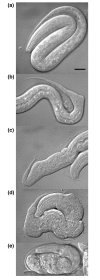Synthetic lethal analysis of Caenorhabditis elegans posterior embryonic patterning genes identifies conserved genetic interactions
- PMID: 15892873
- PMCID: PMC1175957
- DOI: 10.1186/gb-2005-6-5-r45
Synthetic lethal analysis of Caenorhabditis elegans posterior embryonic patterning genes identifies conserved genetic interactions
Abstract
Phenotypic robustness is evidenced when single-gene mutations do not result in an obvious phenotype. It has been suggested that such phenotypic stability results from 'buffering' activities of homologous genes as well as non-homologous genes acting in parallel pathways. One approach to characterizing mechanisms of phenotypic robustness is to identify genetic interactions, specifically, double mutants where buffering is compromised. To identify interactions among genes implicated in posterior patterning of the Caenorhabditis elegans embryo, we measured synthetic lethality following RNA interference of 22 genes in 15 mutant strains. A pair of homologous T-box transcription factors (tbx-8 and tbx-9) is found to interact in both C. elegans and C. briggsae, indicating that their compensatory function is conserved. Furthermore, a muscle module is defined by transitive interactions between the MyoD homolog hlh-1, another basic helix-loop-helix transcription factor, hnd-1, and the MADS-box transcription factor unc-120. Genetic interactions within a homologous set of genes involved in vertebrate myogenesis indicate broad conservation of the muscle module and suggest that other genetic modules identified in C. elegans will be conserved.
Figures



References
Publication types
MeSH terms
Substances
Grants and funding
LinkOut - more resources
Full Text Sources

